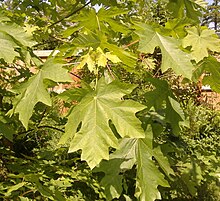Bigleaf Maple
| Acer macrophyllum subsp. var. | Bigleaf Maple, Oregon maple | |||||||||||||||||||||||||||||||||||||||||||||||||||||||
|---|---|---|---|---|---|---|---|---|---|---|---|---|---|---|---|---|---|---|---|---|---|---|---|---|---|---|---|---|---|---|---|---|---|---|---|---|---|---|---|---|---|---|---|---|---|---|---|---|---|---|---|---|---|---|---|---|

|
|
| ||||||||||||||||||||||||||||||||||||||||||||||||||||||
| ||||||||||||||||||||||||||||||||||||||||||||||||||||||||
Acer macrophyllum (Bigleaf Maple or Oregon Maple) is a large deciduous tree in the genus Acer.
It grows to be up to 35 m tall, but more commonly 15 m to 20 m tall. It is native to western North America, mostly near the Pacific coast, from southernmost Alaska south to southern California. Some stands are also found inland in the foothills of the Sierra Nevada mountains of central California, and a tiny population occurs in central Idaho.[1][2]
It has the largest leaves of any maple, typically 15-30 cm across, with five deeply-incised palmate lobes, with the largest running to 61 cm.
The flowers are produced in spring in pendulous racemes 10-15 cm long, greenish-yellow with inconspicuous petals. The fruit is a paired winged samara, each seed 1-1.5 cm diameter with a 4-5 cm wing.[1][2]
Bigleaf maple can form pure stands on moist soils in proximity to streams, but are generally found within riparian hardwood forests or dispersed, (under or within), relatively open canopies of conifers, mixed evergreens, or oaks (Quercus spp.).[3]. In cool and moist temperate mixed woods they are one of the dominant species [4].
| Standard Cyclopedia of Horticulture |
|---|
|
Acer macrophyllum, Pursh. Large-leaved Maple. Tree, to 100 feet high: lvs. cordate, deeply 3-5-lobed or cleft, pubescent when young, pale green beneath, 8-12 in. across; middle lobe mostly 3-lobed: panicles glabrous, narrow, pendulous, 4-5 in. long: fr. with yellow, bristly hairs, wings spreading at right angles or nearly upright, over 1 in. long. W. N. Amer.—Handsome round-headed tree, remarkable for its large foliage; not hardy in the N.
|
- More information about this species can be found on the genus page.
Cultivation
- Do you have cultivation info on this plant? Edit this section!
Propagation
- Do you have propagation info on this plant? Edit this section!
Pests and diseases
- Do you have pest and disease info on this plant? Edit this section!
Varieties
Gallery
References
External links
- w:Bigleaf Maple. Some of the material on this page may be from Wikipedia, under the Creative Commons license.
- Bigleaf Maple QR Code (Size 50, 100, 200, 500)
Cite error:
<ref> tags exist, but no <references/> tag was found


